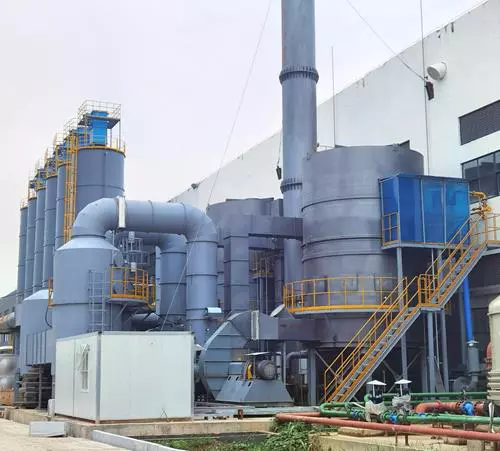Recuperative Thermal Oxidizer for Semiconductor Industry
Giới thiệu
Semiconductor manufacturing involves the use of various chemicals and solvents that emit harmful gases into the atmosphere. These gases contribute to air pollution, which is a significant environmental concern. To mitigate this problem, recuperative thermal oxidizers are increasingly being used in the semiconductor industry. Recuperative thermal oxidizers are pollution control devices that destroy harmful gases and odors emitted during the manufacturing process by converting them into harmless substances.
How does a Recuperative Thermal Oxidizer work?
A recuperative thermal oxidizer works by using high temperatures to convert harmful gases into harmless substances. The process involves heating the polluted air to a temperature of approximately 1500¡ãF while mixing it with an adequate amount of oxygen. The mixture is then passed through a heat exchanger that recovers the heat generated during the process. The heat is then used to preheat the incoming polluted air, reducing the amount of energy required to reach the desired temperature. As the gases flow through the combustion chamber, they are oxidized and converted into carbon dioxide, water vapor, and heat. The purified air is released into the atmosphere, while the heat generated can be recovered and used to preheat incoming air, reducing energy consumption.
Benefits of using Recuperative Thermal Oxidizers in Semiconductor Industry
Using recuperative thermal oxidizers in semiconductor manufacturing brings several benefits, including:
- Reduced air pollution: Recuperative thermal oxidizers reduce the amount of harmful gases emitted into the environment, thus reducing air pollution.
- Compliance with regulations: The use of recuperative thermal oxidizers helps to comply with environmental regulations and avoids penalties that may arise from non-compliance.
- Energy efficiency: Recuperative thermal oxidizers are energy-efficient, and the heat generated during the process can be recovered and used to preheat incoming air, reducing energy consumption.
- Cost savings: Recovering the heat generated during the process can lead to significant cost savings on energy bills, making recuperative thermal oxidizers a cost-effective solution.
- Improved workplace safety: The use of recuperative thermal oxidizers improves workplace safety by eliminating harmful gases, which can be dangerous when inhaled by workers.
Types of Recuperative Thermal Oxidizers
There are two main types of recuperative thermal oxidizers: the direct-fired recuperative thermal oxidizer and the indirect-fired recuperative thermal oxidizer.
Direct-fired Recuperative Thermal Oxidizer
Direct-fired recuperative thermal oxidizers are used when the concentration of volatile organic compounds (VOCs) is relatively high. The process involves burning the gases directly in the combustion chamber, and the heat generated is used to preheat the incoming air.
Indirect-fired Recuperative Thermal Oxidizer
Indirect-fired recuperative thermal oxidizers are used when the concentration of VOCs is low. The process involves heating the gases indirectly by passing them through a heat exchanger. The heat generated is then used to preheat the incoming air.
Phần kết luận
Recuperative thermal oxidizers are an effective solution for reducing harmful gas emissions in the semiconductor industry. The benefits of using these devices include reduced air pollution, compliance with regulations, energy efficiency, cost savings, and improved workplace safety. The two main types of recuperative thermal oxidizers are direct-fired and indirect-fired, each with their specific applications. Adopting the use of recuperative thermal oxidizers in semiconductor manufacturing not only helps to protect the environment but also ensures compliance with government regulations and promotes workplace safety.

Giới thiệu công ty
We are a high-tech manufacturing enterprise specializing in comprehensive treatment of volatile organic compound (VOC) exhaust gas and carbon reduction and energy-saving technologies. Our core technologies include thermal energy, combustion, sealing, and automatic control. We have capabilities in temperature field simulation, air flow field simulation modeling, ceramic heat storage material performance, molecular sieve adsorption material selection, and VOC high-temperature incineration and oxidation experimental testing.
Ưu điểm của đội
We have established an RTO technology research and development center and an exhaust gas carbon reduction engineering technology center in Xi’an, as well as a 30,000 square meter production base in Yangling. We are a leading manufacturer of RTO equipment and molecular sieve wheel equipment in terms of production and sales volume globally. Our core technical team comes from the Aerospace Liquid Rocket Engine Research Institute. We currently have over 360 employees, including more than 60 R&D technology backbones, including 3 senior engineers with research-level qualifications, 6 senior engineers, and 55 thermodynamics PhDs.
Sản phẩm cốt lõi
Our core products include the Rotary Valve Thermal Oxidizer (RTO) and molecular sieve adsorption concentration wheel. Combined with our expertise in environmental protection and thermal energy system engineering, we can provide customers with comprehensive solutions for industrial exhaust gas treatment, carbon reduction, and thermal energy utilization under various operating conditions.
Chứng nhận, Bằng sáng chế và Danh hiệu
- Chứng nhận hệ thống quản lý sở hữu trí tuệ
- Chứng nhận hệ thống quản lý chất lượng
- Chứng nhận hệ thống quản lý môi trường
- Chứng chỉ Doanh nghiệp ngành xây dựng
- Doanh nghiệp công nghệ cao
- Patent for Rotary Valve Thermal Oxidizer
- Patent for Rotary Heat Storage Incineration Equipment
- Patent for Disc Molecular Sieve Wheel

Lựa chọn thiết bị RTO phù hợp
- Determine exhaust gas characteristics
- Understand local regulations and emission standards
- Đánh giá hiệu quả năng lượng
- Xem xét hoạt động và bảo trì
- Phân tích ngân sách và chi phí
- Chọn loại RTO phù hợp
- Xem xét các yếu tố môi trường và an toàn
- Kiểm tra và xác minh hiệu suất
Explanation:

Quy trình dịch vụ
- Consultation and evaluation
- Design and solution development
- Production and manufacturing
- Installation and commissioning
- After-sales support
Explanation:
We are a one-stop solution provider with a professional team dedicated to customizing RTO solutions for our customers.
About the Author
Tác giả: Miya
